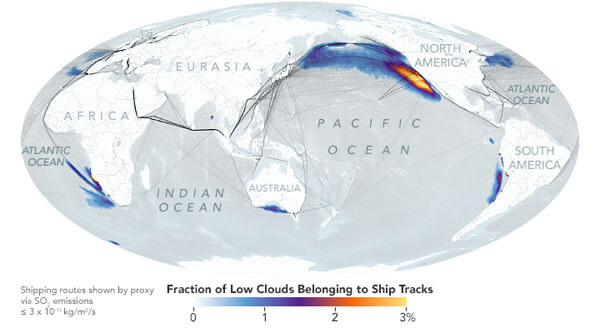NASA: IMO Adoption of Low Sulfur Fuel Reduced Pollution from Ships

The adoption of the low sulfur fuel oil regulations for the shipping industry has a positive effect in reducing the clouds of pollution according to a new report released by NASA. According to the report, the global standard limiting sulfur in ship fuel introduced by the International Maritime Organization reduced artificial “ship track” clouds to record-low levels in 2020 highlighting the importance of the efforts to address ship emissions.
Drawing on nearly two decades of satellite imagery, NASA reports that researchers found that the number of ship tracks has fallen significantly. The scientists used advanced computing techniques to create the first global climatology (a history of measurements) of ship tracks. They analyzed the daytime imagery from a 17-year period (2003-2020) concluding that the only explanation was the IMO’s regulation that reduced sulfur content by 86 percent.
“Without this kind of complete and large-scale sampling of ship tracks, we cannot begin to completely understand this problem,” said lead author Tianle Yuan, an atmospheric scientist at NASA’s Goddard Space Flight Center in Greenbelt, Maryland, and the University of Maryland, Baltimore County.
The researchers explained that ship tracks were first observed as “anomalous cloud lines” in early weather satellite images acquired in the 1960s. The trails or “ship tracks” are formed by water vapor coalescing around small particles of pollution in ship exhaust. The highly concentrated droplets scatter more light and therefore appear brighter than non-polluted marine clouds, which are seeded by larger particles such as sea salt. NASA scientists have been studying these tracks theorizing they could be used to monitor shipping activity and its impact.

Researchers observed that the tracks fell in 2020 after the new low sulfur fuel regulations (NASA Earth Observatory)
While analyzing 2020 data, the researchers found that ship-track density fell that year in every major shipping lane. In their analysis, they linked the visible changes to the IMO’s capping fuel sulfur content at 0.5 percent in 2020. According to the researchers, the requirement for the use of Low Sulfur Fuel Oil (LSFO) changed the chemical and physical composition of ship exhaust. Less sulfur emissions mean there are fewer aerosol particles released to form detectable ship tracks.
They considered that disruptions to shipping activity related to the COVID-19 pandemic might have played a role in the changes. They concluded that the pandemic played a role in decreasing global shipping traffic by 1.4 percent for a few months. “But this change alone could not explain the large decrease in observed ship tracks, which remained at record-low levels through several months of 2021,” writes NASA.
According to Yuan and his colleagues, similar but regionally defined sulfur regulations – such as an IMO Emission Control Area in effect since 2015 off the west coast of the U.S. and Canada – did not have a similar effect. They believe that is because operators altered their routes and charted longer courses to avoid designated zones.
The analysis also showed clear patterns with the visible “anomalous cloud lines” directly correlating to the level of shipping activity. Over the long span of their analysis, Yuan and his colleagues also found that a general upward trend in shipping activity between 2003 and 2013 was reflected in the observed ship-track clouds. They could also detect declines in the tracks for example for about a year in the aftermath of the 2008 global financial crisis and similarly between 2014 and 2016 likely reflected a slowdown in Chinese imports and exports of raw materials and commodities.
Beyond their world trade significance, ship tracks the researchers highlighted can serve as case studies for an element of climate change. “Ship tracks are great natural laboratories for studying the interaction between aerosols and low clouds, and how that impacts the amount of radiation Earth receives and reflects back to space,” Yuan said. Like ghostly fingerprints, they said the tracks trace shipping lanes around the globe, from the North Pacific to the Mediterranean Sea.
News of their visual evidence of the impact of shipping on the atmosphere came as the European Parliament today took the first definitive steps to compel shipping to reduce greenhouse gas emissions and adopt mandates for the use of alternative fuels. The adoption of the measures and the upcoming efforts with the members of the European Commission is seen as the first step requiring the transitioning of shipping away from fossil fuels.
